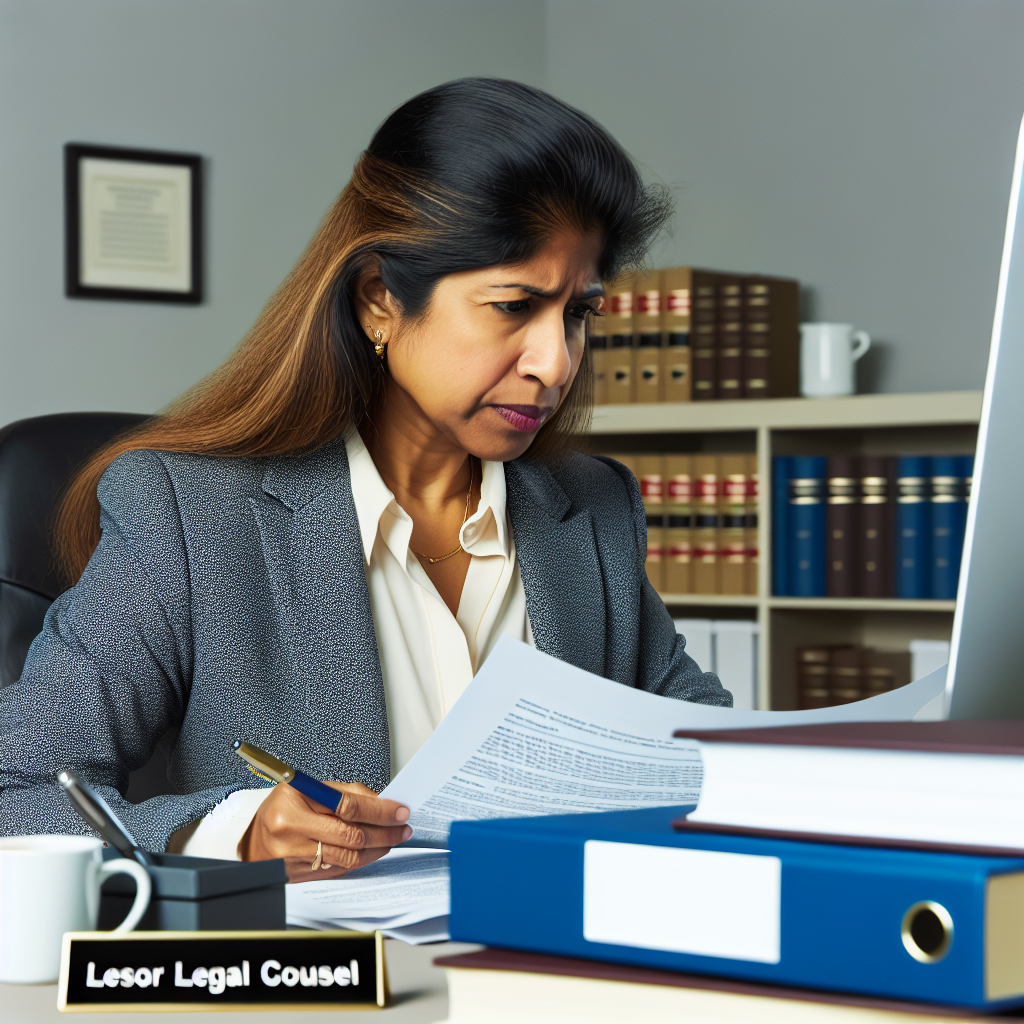Understanding the Importance of Lease Agreements
Legal Protection for Both Parties
Lease agreements serve as legally binding contracts.
They protect the rights of both landlords and tenants.
By clearly outlining responsibilities, they prevent disputes.
Furthermore, lease agreements ensure compliance with local laws.
Financial Security
Lease agreements provide financial protection for landlords.
They outline payment terms and due dates clearly.
This establishes a payment schedule for tenants to follow.
Additionally, they can include late fees for non-compliance.
Clarity in Terms and Conditions
Leases define the terms of occupancy in detail.
They specify the duration of the lease period.
They clarify the use of the property and maintenance responsibilities.
Moreover, lease agreements can outline rules for communal areas.
Creating Stability
Stable lease agreements foster long-term relationships.
They benefit tenants by providing housing security.
Moreover, they help landlords by reducing tenant turnover.
This can lead to a more consistent rental income over time.
Facilitating Legal Actions
In cases of dispute, leases serve as important evidence.
They simplify legal processes for eviction or other actions.
Lease agreements can help resolve conflicts swiftly and fairly.
Thus, they provide a vital framework for addressing issues.
Essential Components of a Lease Agreement
Identification of Parties
The lease agreement must clearly identify all parties involved.
This includes the landlord and the tenant.
Use full names to avoid confusion.
Additionally, include contact information for all parties.
Property Description
Provide a detailed description of the rental property.
Include the address and any specific details.
For example, mention the type of property, such as an apartment or house.
This helps prevent disputes later on.
Lease Term
Specify the length of the lease term in the agreement.
This can range from months to years.
Make sure to include the start and end dates.
Also, outline any renewal terms if applicable.
Rent Payment Details
Clearly state the rent amount in the agreement.
Outline the due date for rent payments.
Include acceptable payment methods and penalties for late payments.
Additionally, specify the frequency of payments, such as monthly or quarterly.
Security Deposit
Detail the amount required for the security deposit.
Explain how the deposit will be handled during the lease.
Include information on conditions for its return after lease termination.
This protects both parties in case of damages or unpaid rent.
Maintenance Responsibilities
Clearly outline the maintenance responsibilities for both parties.
This helps avoid confusion over who is responsible for repairs.
Specify which party handles routine maintenance and urgent repairs.
Rules and Regulations
List any specific rules and regulations related to the property.
This may include restrictions on pets or noise levels.
Make sure tenants understand these rules to ensure compliance.
Termination Clauses
Include a termination clause in the lease agreement.
This explains how either party can end the lease early.
Specify required notice periods and reasons for termination.
Signatures
Finally, provide space for all parties to sign the agreement.
This formalizes the lease and indicates acceptance of its terms.
Ensure both parties receive a copy of the signed agreement.
Legal Considerations and Regulations for Lease Agreements
Understanding Lease Laws
Every state has its own leasing laws and regulations.
It is crucial to research local laws before drafting any agreements.
Understanding these laws protects both the landlord and tenant.
Essential Elements of a Lease Agreement
A lease agreement must contain specific key elements.
First, it should clearly state the names of the parties involved.
Additionally, it must outline the property being leased.
Specify the duration of the lease to avoid confusion.
Clearly state the rental amount and payment due dates.
Lastly, outline the responsibilities of both parties.
Regulatory Compliance
Compliance with local and federal regulations is mandatory.
Failing to comply can result in legal issues and penalties.
For instance, various states have different requirements for security deposits.
Ensure the lease agreement meets all local building codes.
Fair Housing Act Considerations
Landlords must adhere to the Fair Housing Act regulations.
This act prohibits discrimination based on race, color, or religion.
It extends to familial status, disability, and national origin as well.
Ensure that lease agreements do not contain discriminatory language.
Tenant’s Rights and Responsibilities
Tenants have rights that must be honored in any lease agreement.
They must be informed about any terms and conditions clearly.
Tenants have the right to a safe and habitable living environment.
Additionally, they should know their responsibilities regarding property maintenance.
Importance of Written Agreements
Verbal agreements can easily lead to misunderstandings.
A written lease agreement provides clarity and legal protection.
Both parties should review and sign the document to ensure mutual agreement.
Keep copies of the lease for future reference.
Delve into the Subject: Avoiding Common Pitfalls In Rent Collection And Financial Management
Drafting Clear and Concise Terms and Conditions
Importance of Clarity in Lease Agreements
Clarity is essential when drafting lease agreements.
Ambiguous language can lead to misunderstandings.
Both parties should understand their rights and responsibilities clearly.
Structuring Lease Terms Effectively
Begin with a straightforward introduction.
Include the names of all parties involved.
Clearly define the leased property.
State the lease term, including start and end dates.
Detailing Financial Obligations
Outline the rent amount explicitly.
Specify payment due dates to avoid late fees.
Include information about security deposits.
Clarify any additional fees associated with the lease.
Communicating Rights and Responsibilities
Describe the responsibilities of the landlord and tenant.
Include guidelines for property maintenance.
Specify pet policies, if applicable.
Address rules regarding alterations to the property.
Incorporating Legal Considerations
Ensure compliance with local laws and regulations.
Include terms regarding early termination of the lease.
Establish processes for conflict resolution.
Seek legal advice to enhance the lease’s enforceability.
Review and Revisions
Review the lease with all involved parties.
Encourage questions to address concerns.
Make revisions based on feedback received.
Finalize and sign the agreement to make it binding.
Discover More: How To Use Tenant Screening Reports To Protect Your Rental Investments
Incorporating Security Deposits and Rent Payments
Understanding Security Deposits
A security deposit protects landlords from financial loss.
It covers damages or unpaid rent at lease end.
Typically, tenants pay this deposit upfront.
Ensure the amount complies with local laws.
For instance, some regions cap deposits at one month’s rent.
Documenting the Security Deposit
Clearly specify the deposit in the lease agreement.
Include details on the amount and conditions for its return.
Make sure to outline acceptable deductions.
For example, deductions may apply for damages or cleaning fees.
Establishing Rent Payment Terms
Define rent payment frequency in your lease.
Most landlords opt for monthly rent payments.
Clearly state the due date for payments.
Consider offering multiple payment methods for convenience.
Addressing Late Payments
Include late payment penalties in the lease.
Detail the grace period before penalties apply.
This can help encourage timely payments from tenants.
Communicate these terms clearly to avoid disputes.
Implementing Rent Increases
Outline how and when rent increases may occur.
It’s common to include annual increases in lease agreements.
Ensure to follow local regulations regarding notice periods.
This helps foster trust and transparency with tenants.
Maintaining Clear Communication
Provide tenants with clear contact information for rent-related queries.
Open communication channels can prevent misunderstandings.
Encourage tenants to voice concerns promptly.
This approach builds a positive landlord-tenant relationship.
Explore Further: Smart Tenant Screening Practices To Avoid Problematic Renters

Defining Maintenance Responsibilities and Repairs
Importance of Clearly Defined Roles
Clearly defining maintenance responsibilities protects both landlords and tenants.
It prevents disputes and creates accountability for property upkeep.
Furthermore, it establishes a mutual understanding of expectations.
Outlining Landlord Responsibilities
Landlords typically bear certain maintenance responsibilities.
These responsibilities often include essential repairs and property upkeep.
-
Maintaining the building’s structural integrity.
-
Ensuring plumbing and electrical systems are functional.
-
Addressing any pest control issues promptly.
Additionally, landlords must respond to maintenance requests in a timely manner.
Tenant Maintenance Obligations
Tenants also have maintenance duties outlined in the lease agreement.
They should keep the property clean and report damages promptly.
-
Responsible for minor repairs, like changing lightbulbs.
-
Responsible for maintaining appliances if specified.
-
Responsible for yard work if the rental includes outdoor space.
Moreover, tenants should seek permission before making significant changes.
Addressing Repairs in Lease Agreements
Clearly stipulating how repairs will be handled is crucial.
This includes establishing procedures to follow for repairs.
-
Define timelines for urgent and non-urgent repairs.
-
List any limitations on repairs that tenants can perform.
-
Specify how repair costs will be handled, if applicable.
Furthermore, it’s vital to include contact information for repair requests.
Insurance and Liability Considerations
Both parties should understand their insurance responsibilities.
Landlords often require tenants to have renters insurance.
This protects personal belongings and liabilities within the rental.
In contrast, landlords should maintain property insurance covering structural issues.
Creating a Maintenance Response Strategy
A clear response strategy benefits everyone involved.
This might include a maintenance request form for tenants.
Such a form simplifies the communication process about repairs.
-
Specify the nature of the issue.
-
Include urgency levels for different types of repairs.
Furthermore, regular maintenance check-ups can prevent serious issues.
See Related Content: Importance Of Credit Checks In Tenant Screening For Rental Properties
Creating Clauses for Termination and Renewal
Importance of Termination Clauses
Termination clauses provide clear guidelines for ending a lease.
They protect both parties from unexpected circumstances.
Without these clauses, disputes may arise.
Defining Grounds for Termination
Clearly define the grounds for termination in the lease agreement.
Common grounds include non-payment, property damage, and violations of lease terms.
Detail the process for notifying the other party before termination.
Consideration of Notice Periods
Specify the notice period required before termination.
This period allows both parties to adjust to the situation.
A typical notice period ranges from 30 to 60 days.
Renewal Clauses as an Option
Include renewal clauses to provide options for both parties.
These clauses can specify the length and terms of renewal.
They help in preventing uncertainty at the end of the lease term.
Setting Renewal Conditions
Clearly articulate conditions under which a lease can be renewed.
Consider factors such as rental rate adjustments and property conditions.
Outline who has the right to initiate the renewal process.
Incorporating Automatic Renewal Options
Automatic renewal options can benefit both landlords and tenants.
Clearly state the terms under which renewal occurs automatically.
Provide an option for either party to opt out and terminate the lease.
Addressing Changes in Terms
Specify how terms may change upon renewal.
Include possible adjustments in rental rates or maintenance responsibilities.
This clarity ensures both parties are aware of potential changes.
Legal Considerations
Always comply with local laws and regulations regarding lease agreements.
Consult with legal professionals to ensure your clauses are enforceable.
This step reduces the risk of legal disputes in the future.
The Role of Legal Professionals in Reviewing Lease Agreements
Importance of Legal Review
Legal professionals ensure that lease agreements are legally sound.
They identify potential issues that can affect your rights.
Furthermore, their expertise helps in drafting clear and enforceable terms.
Key Aspects of Legal Review
One significant aspect is understanding local rental laws.
Legal professionals confirm that the lease complies with these regulations.
Additionally, they assess the lease for clarity on payment terms.
This includes rent amount, payment due dates, and penalties.
Protecting Your Interests
Attorneys help protect your interests by recommending necessary clauses.
Common clauses include security deposits and maintenance responsibilities.
Moreover, they can include terms to safeguard against premature lease termination.
Resolving Disputes
Legal professionals also assist in dispute resolution provisions.
They may recommend mediation or arbitration clauses.
This approach can save time and resources compared to court actions.
Legal Assistance in Lease Agreements
Involving legal professionals in lease agreements is essential.
Their insights protect your interests and ensure compliance.
Thus, you can enter rental agreements with confidence.




